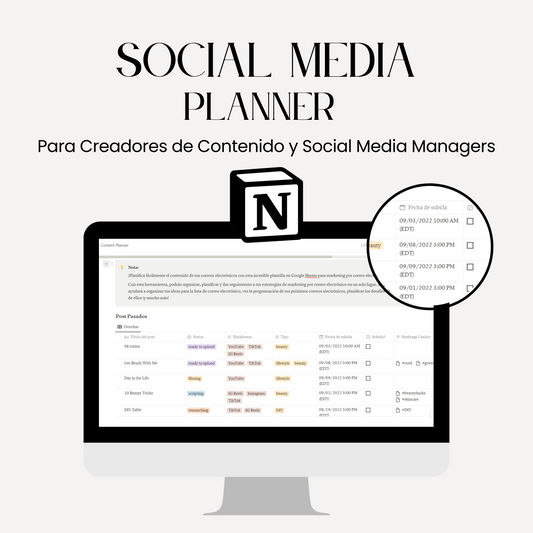Hello! If you're interested in collaborating with brands to create content on social media like TikTok and Instagram, you're in the right place! Brands today are looking to not only collaborate with influencers, but also with everyday people who can create compelling and authentic content.
The secret to being successful in these collaborations is to understand that it is not just about doing a review , but about creating specific content that the brand is looking for to promote itself. In summary, you contact the brand (or the brand contacts you), you receive a product, you make a video and the brand pays you for it.
But what is User Generated Content?
What does UGCC mean? The UGC (acronym), or User Generated Content, is a term that refers to the content that users or consumers create for companies. This type of content may include text, images, videos, reviews, and any other type of information created by users rather than by companies or brands. It is something that has been around for a long time, but lately it has become popular, since companies need to be constantly generating content for their social networks. Therefore, in this case we are going to see in detail the content that brands can use for their own digital channels, and their Content Marketing strategy.
What is the UGC used for?
If you want to create content and have brands contact you, it is important that you understand why it is so important for companies. UGC in digital marketing is valuable to companies and brands for several reasons:
- Provide fresh and relevant content for the company's website or social media.
- It helps increase brand trust and credibility , since the content is created by real consumers and not by the company.
- You can generate interaction and engagement with the audience, since users can comment and share the content.
- It can increase the reach and visibility of the brand, since the UGC can be shared
UGC how to start in Spanish How to do UGC for brands without being an influencer
The emergence of UGC creators opens the door for more people to create content for brands (and get paid) regardless of the number of followers.
The good news is that you don't need a fan base or specific education to be a content creator (although you should be into photography/editing). However, it does take time, skills, consistency, hard work, and a constant stream of income before you can consider yourself a full-time content creator. So don't quit your day job just yet.
So what does it take to be a social media content creator? Let's see step by step how you can go about being a UGC creator:
- Identify brands to work with
- create content
- build your portfolio
- Be patient. Little by little
-
Tip #1: Identify the type of brands you want to work with
Before you start creating UGC, make a list of brands you'd love to work with.
If that's too specific, consider the industry you'd like to work in: Wellness? Fashion? B2B? Technology? Sports?
From there, spend time auditing the content they already publish:
What content seems to be working for them? Which posts get the most comments or views?
Do you post a lot of UGC? If so, what does it look like?
What would grab your attention and make you stop scrolling?
Who is your target audience? What is your brand voice?
Are there any gaps in its content? Could they benefit from more TikTok Reels or tutorials?
Remember: UGC works well because it looks authentic.
Working with brands in an industry you care about will make collaboration a dream and let your genuine connection to their product shine through.
In addition to being clear about which brands you'd like to work with, it's important that you spend time researching and analyzing their social media presence and the content they post. This will help you better understand their marketing strategy and identify what type of content works best for them.
If you notice that a brand publishes a lot of user-generated content (UGC), take a look at how it looks and what elements make it stand out. User-generated content often works well because it is authentic and reflects the actual experience of consumers.
It is also important to consider who the brand's target audience is and what its brand voice is. This will help you understand what type of content and tone of voice might work best in a collaboration.
If you find a gap in a brand's content, it can be an opportunity to come up with new content ideas, like creating Instagram Reels or TikTok tutorials. By working together to develop content that meets the needs of the brand, the collaboration is more likely to be successful and long-lasting.
Ultimately, working with brands in an industry you're interested in can make collaboration more exciting and authentic. By having a genuine connection to the product, you will be able to create more authentic and relevant content for the brand's audience.
-
Tip #2: Create content - practice makes perfect
Establish the type of content you want to specialize in, or if you will be a generalist.
If you'd like to focus on images, it might be worth taking some basic photography courses. If you're more comfortable in front of the camera, create short-form videos that work well on Reels, TikTok, or Stories.
You can also practice on your own account. This will help you build your portfolio as you experiment with different features and styles of content.
When deciding the type of content you want to specialize in, it's important to consider the skills and resources you need to produce it. If you want to be a video content creator, make sure you have a good camera, microphone, and video editing software. If you want to focus on written content, spend time improving your writing and grammar skills.
Practicing on your own account is a great way to develop your skills and find out what kind of content you like to create. Start by identifying your audience and creating content that resonates with them. Analyze your social media stats to understand which posts are performing best and which ones need improvement.
Keep up with the latest trends in the industry and experiment with different content styles and formats. Remember that quality content takes time and effort, so don't be afraid to ask for feedback and look for ways to constantly improve.
Finally, it is important that you are consistent in the creation and publication of content. Schedule a posting schedule so you can keep your audience engaged and make sure your content is relevant and current.
-
Tip #3: Create and build your portfolio
Surely you have heard of the Media Kit for influencers . However, in case you want to do UGC, it is best to create a portfolio. Building a portfolio can help you present your ideas to brands more effectively, highlight your work, and build long-term collaborations.
We recommend using a Canva template to create a portfolio that explains who you are, why the brand needs UGC, and past work.
It is important that you consider the type of content that you will include in your portfolio. Make sure your work is organized clearly and coherently so it's easy to navigate.
Include a variety of previous jobs that demonstrate your content creation skills and experience. If you have experience working with brands in a specific industry, be sure to include examples of content you've created for those brands.
You can also include relevant statistics to support the success of your previous collaborations. For example, if one of your collaborations generated a large number of views or comments, be sure to include that information in your portfolio.
Keep your portfolio up to date and add new jobs and stats as you create them. This will help your portfolio stand out and demonstrate your ability to create relevant and successful content.
Finally, use your portfolio as a tool to introduce yourself to brands. Share your portfolio in your emails and on your social networks to make sure that brands know about your work and your skills as a content creator.
-
Tip #4: Be patient. Little by little
It's important to note that building a strong social media presence and establishing partnerships with brands takes time and effort. Don't be discouraged if you don't get an immediate response from the brands you're targeting or if your following doesn't grow quickly.
Continue creating quality content and building your personal brand. Be constant in your strategy and be patient. As you grow on social media, you'll have more opportunities to collaborate with brands that fit your interests and content style.
Remember that authenticity and dedication are key to establishing lasting and successful relationships with brands. Don't give up and keep working hard to achieve your social media goals.
other tips
- Create original and quality content: Make sure your content is unique and offers something of value to your audience.
- Use relevant hashtags: In your personal content, use hashtags like #ugc or industry you are interested in. Today there are many companies proactively looking for content creators on social networks. So it can be a good way for them to get to you instead of the other way around.
- Be authentic and transparent: Do not try to pretend to be someone you are not. Be authentic and transparent in your posts and in your interactions with other users.
- Be active: Post regularly and keep up with current trends and topics.
How to find brands to create UGC (user-generated) content for them
- Use search tools: There are tools online that allow you to search for brands and companies that are interested in collaborating with influencers or content creators.
- Look at the brand pages: Many brands have sections on their websites or on their social networks where they invite you to collaborate with them. Review these sections to see if there are opportunities for collaboration.
- Contact brands directly: If there's a specific brand you'd like to collaborate with, don't be afraid to send them an email or direct message asking if they'd be interested in working with you.
Common questions when you want to start creating content for brands
- What industries are the best paying?
Beauty and big brands
- How should the contract be? How much can I charge brands?
The contract will depend on the brand. And what you can charge too. Think about the size of the company before saying what your job costs.
- Product vs payment (don't be afraid that they won't want to work with you)
If you are starting, accept collaborations by product to start having your portfolio
- Are most of the markings in English?
Today, many collaborations are in English, since it is a trend that, like almost everything in marketing, comes from the US. But in Spain and other Latin American countries it is increasingly seen.
- What about the product they send it to you for free? Or do they subtract from your payment?
Each brand is a world. It is best to negotiate with her.
- Can I increase my income by creating content?
Yes, brands pay very well for well-done content
- How to know which brands to contact?
Brands that you like and can be, that you know that they already do UGC collaborations
- Are there applications to be able to contact or know which brands to contact?
It is best to write to them directly, attaching your portfolio or media kit
- Can you publish the content you create for brands on your own social networks? And in my portfolio?
As a general rule, yes, but always ask the brand first
Why Brands Against Content Generation or UGC?
When brands use UGC as part of their marketing strategy, they're not just selling products; they are also building relationships and increasing conversions.
Let's look at the benefits of using UGC builders:
-
Benefit #1: Build a bank of content
Creating content is often a time-consuming process, especially for social media managers and entrepreneurs who do it all on their own.
UGC creators open the doors to a constant stream of content that you didn't have to create yourself. You just have to give instructions to the creators and, depending on the contract (and if it's an ongoing partnership), you may receive several new deliverables on a monthly basis. It's a win win!
-
Benefit #2: Build trust
UGC content has always been successful in building trust because it looks like a word of mouth recommendation from a friend or family member.
By working with UGC creators, brands can publish content that resembles UGC, typically less "glamorous" or "branded", to make it appear more organic, provide use cases, and ultimately build trust.
It's the perfect solution to showcase your brand without looking too promotional or salesy.
-
Benefit #3: Cheaper than big influencer campaigns
Influencer campaigns are an important tactic for reaching new audiences, but depending on the type of creators you work with (macro or mega, for example), the money can add up.
This is especially true if it's going to be a one-off, one-off partnership for a launch or event.
On the other hand, working with UGC creators on an ongoing basis allows you to use their content on your channels, build your audience, and can also keep costs in check.
-
Benefit #4: Drive sales
As we mentioned, UGC contributes significantly to conversion.
Because when users see real people using a brand's product or service, they're more likely to open their wallet.
User generated content examples
Let's see what UGC is in social networks. If you use TikTok you will see that there are many people talking about this. And it is that it has become a way to monetize your content without the need to have many followers. That is, you can do collaborations with brands without having followers.








35 comments
Apenas me he enterado de esto y la verdad quiero saber más me interesa mucho
Quiero formar parte del equipo, me pueden orientar como empezar ?
Quiero formar parte del equipo, me pueden orientar como empezar ?
Soy nueva UGC y me gustaría saber más t conocer más sobre esta experiencia en creador de UGC y poder aprender a realizar videos de buena calidad y tener buenas ideas para plantear mis videos
Hola, sería un gusto y un placer evolucionar junto con empresas para así promocionar sus productos de una manera efectiva y beneficiosa y ganar experiencia.